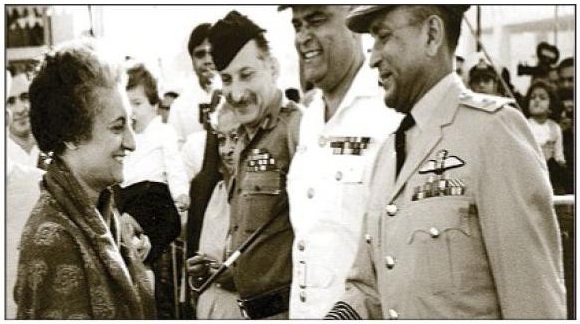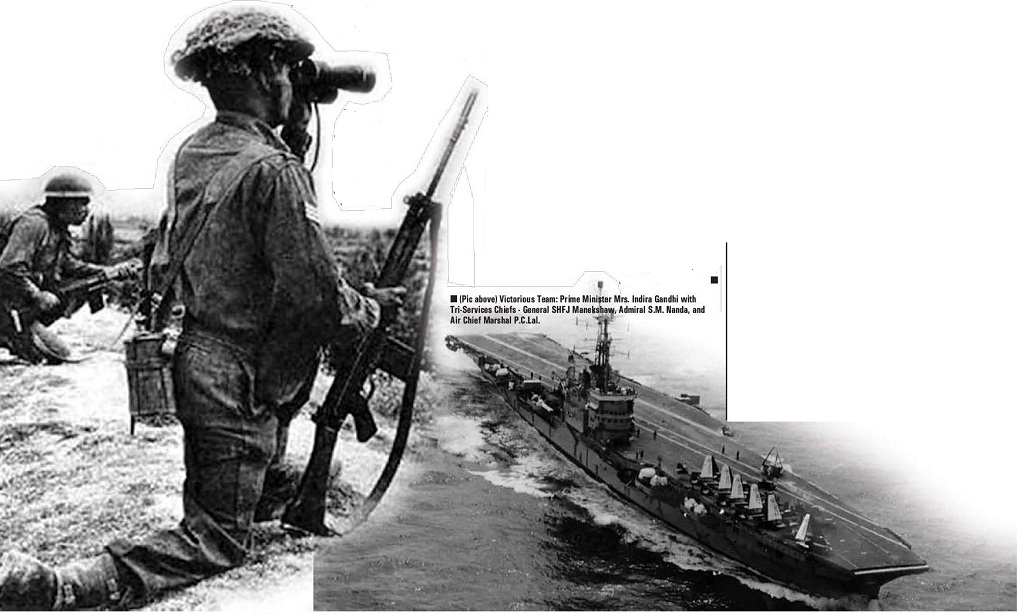WAR 1971 GOLDEN COMMERATION
| Date :12-Dec-2021 |

By VIJAY PHANSHIKAR :
V ictory was already in India’s kitty -- though formal document of surrender would come in a few hours. Assured of all correct details, General Sam Manekshaw entered the office of Prime Minister Mrs. Indira Gandhi, offered her a kadak salute, smiled cautiously and said in a formal tone, ‘Prime Minister, we have achieved our purpose. Official surrender will follow’. Mrs. Indira Gandhi responded with a controlled smile and said, ‘Thank you General. My congratulations’. Unprecedented nationwide celebrations would follow in some time, but when as the Chief of Army Staff of the victorious Indian Army General Manekshaw stood before the Prime Minister, the faces of both of them showed a wonderful blend of jubilation plus responsibility -- besides the gravitas of the moment of history. Both knew very well that that precious moment had come riding on the shoulders of the body of long-drawn conflict between two estranged neighbours -- India and Pakistan -- right from the time of Partition. As we celebrate the fiftieth anniversary of that historic victory, we do not necessarily celebrate the formation of Bangladesh following the 13-day war that culminated on December 16, 1971. In actuality, we celebrate that moment of history when India asserted itself as an emerging Asian power that could redraw the world’s political map. We celebrate the truth of India’s political will, military prowess, resolute leadership -- that finally started carving a path of formidable dominance in Asia’s geopolitical arena.

As we tell ourselves that great story at this point in time again, we recount how India, then a fledgling nation of just 24 years of self-rule, rose from its state of weakness to a position of appreciable strength in such a short time. It was just 9 years earlier in 1962 that India had suffered an shameful defeat at the hands of China in the Himalayas. Then came the Pakistani misadventure of 1965 when the Indian military machine had recollected itself from the crushing experience three years earlier -- and handed down to the invaders an authentic drubbing to assert itself. And then came the conflict of 1971, in just 6 years, which Pakistan ignited as part of its incorrigible habit. The day -- December 16, 1971 -- therefore symbolised how Pakistan led itself to its own dismemberment, whose seeds it sowed much before its formation in August 1947. In fact, as the Muslim League, led by the obstinate, unthinking, illogical, perverse Barrister Mohammad Ali Jinnah, pushed for a separate country based on religion, it sowed the seeds of the destruction of the new country that could never transform itself into a nation. For, the very political ideology that the Muslim League adopted was steeped in belief in violence, strengthened by (uncalled for) hatred for the majority Hindu community.
One of the attributes of that ideology was banditry and savagery whose evidence came in different ways -- terrible violence whose orgy started years before Partition, continued through Partition, and was picked up as official way of thinking later. As part of that came the unprovoked attack on Kashmir at the dawn of Independence. And what followed was nothing but a train of Pakistan-masterminded events that ultimately led to its own dismemberment. All that history went into that moment on December 16, 1971 when Lt. General Jagjit Singh Arora, the dour Commander in Chief of the Indian Forces in the Eastern sector, accepted the document of surrender signed by East Pakistan’s Army Commander and Administrator Gen. A. A. K. Niyazi. It was the moment of creation of Bangladesh with Indian help, signalling the end of untold misery of the teeming millions of common people who suffered under Pakistan’s military high-handedness or demonic proportions.
It was also the moment when Pakistan kept looking hopelessly at its severed eastern wing and grieving and angering about how events took a terrible and dangerous turn to its doom. Of course, Pakistan would never admit that it was its own vivisector, inviter of its own doom, writer of a dark chapter of its own story. Of course, later events did prove that Pakistan never learned a single right lesson from its own mistakes. December 16, 1971, was the day that should have reminded Pakistan of all its sins. But alas, that would not happen. For, that was destined to happen. But that is not the focus of our celebratory recall of the event now. At this point in time, we recall that moment back in time, how India created a foundational work of its future military prowess. This recall fifty years later is especially sweet against the background of the recent face-off with China in eastern Ladakh when the Indian military machine stood more than equal to China’s so-called invincible juggernaut. Of course, in between also lay a few developments that asserted India’s continually-improving military capabilities and diplomatic savvy -- like the Kargil conflict in which India repulsed the enemy enjoying a superior geographical location, for example.
The details notwithstanding, India kept on consolidating its overall security doctrine and apparatus -- through wellthought reconfiguration of its strategic perception, well-monitored defence-related acquisition as well as a great push to the ordnance industry through Make In India programme. But as we look back on that momentous day -- December 16, 1971 -- we feel that we have every reason to feel proud that India has learned its lessons well, though not at a desirable pace. We could have done still better and arrived at today’s moment with a better and greater military capability and strategic preparedness. But we did lose precious years in between that moment fifty years ago and now, and so allowed a slower progress on this critical count. But back then on that day, India had every reason to celebrate its achievement -- of course without losing the historical perspective. That was what reflected in the cautious tone of the interaction between Prime Minister Mrs. India Gandhi and Army Chief General Sam Manekshaw on December 15. Both of them were the persons who made that victory possible -- by offering the nation a terrific combination of political and military leaderships. Both of them showed their multiple capabilities, one of which being sense of restraint. When the country’s political community was baying for immediate military action, it was General Manekshaw who advised restraint and sought time for preparation. Dismissing her own colleagues, Mrs. Indira Gandhi had allowed the General whatever time he asked for -- for a military build up. And when the Army Chief started one of the biggest military mobilisations in contemporary history, Mrs. Gandhi launched a diplomatic offensive to convince the world that India was on the right side of the divide. She also made an astute use of India’s international alliances and safeguarded national interest in very many ways.
THAT wonderful collaboration between the political and the military systems of the country had happened for the first time since Independence. Of course, looking at the current scenario, we are fortunate to have seen its replication now with Prime Minister Mr. Narendra Modi and the military apparatus forging a terrific combination of will and wellness. The country will certainly miss Chief of Defence Staff General Bipin Laxman Singh Rawat. Despite that, we should feel happy that the collective leadership of India at this point showcases a classic example of how a good lesson has been learned well. Against the background of December 16, 1971, the moment of today appears ever sweeter, ever more delicious, and certainly very reassuring -- that we are in safe hands; and that we are very well on the way to becoming a global power in due course of time. This is what the recall of December 16, 1971, brings us to -- the promise of our strength.
■